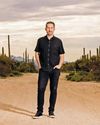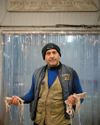
A few years ago, during his commute across California’s Pajaro Valley, Phil Stewart began stopping more regularly at the Burger King in Watsonville. He wasn’t just there for the Whoppers. He was visiting a wild strawberry plant. Stewart, an affable 41-year-old with sandy hair, breeds the fruit for Driscoll’s, the largest player in the $5.6 billion U.S. berry market. He was struck by the plant’s vigor—sprouting at the edge of the sidewalk without much water or soil, blanketed in the exhaust of cars waiting at a stoplight. Stewart dropped in on it for two years, waiting for it to fruit. When at last he found two small berries on the plant and tasted one, it was delicious.
Strawberries grow almost everywhere in the world, though nowhere as bounteously as they do along this particular stretch of the California coast, about 95 miles south of San Francisco, where the Pajaro River empties into Monterey Bay. The Spanish explorer Sebastián Vizcaíno, anchoring nearby in 1602, found wild strawberries in December, which was unheard of in Europe. Explorers to other parts of the New World also discovered strawberries with marvelous advantages in color, size, and flavor, and took botanical specimens home. Two of these crossed to yield the modern strawberry, Fragaria x ananassa, in the 18th century.
Today, California produces almost 29 percent of the world’s strawberries—$2.6 billion worth—a lot of that from the 14,200 acres of fields that surround Watsonville and neighboring Salinas. If you come here to visit those in the business, most conversations conclude with the offer of a 1-pound tub, or sometimes a whole flat. The town’s annual strawberry festival, its 21st is this year, boasts pie eating contests and strawberry pizza.
Diese Geschichte stammt aus der August 3- 9 2015-Ausgabe von Bloomberg Businessweek.
Starten Sie Ihre 7-tägige kostenlose Testversion von Magzter GOLD, um auf Tausende kuratierte Premium-Storys sowie über 8.000 Zeitschriften und Zeitungen zuzugreifen.
Bereits Abonnent ? Anmelden
Diese Geschichte stammt aus der August 3- 9 2015-Ausgabe von Bloomberg Businessweek.
Starten Sie Ihre 7-tägige kostenlose Testversion von Magzter GOLD, um auf Tausende kuratierte Premium-Storys sowie über 8.000 Zeitschriften und Zeitungen zuzugreifen.
Bereits Abonnent? Anmelden

Instagram's Founders Say It's Time for a New Social App
The rise of AI and the fall of Twitter could create opportunities for upstarts

Running in Circles
A subscription running shoe program aims to fight footwear waste

What I Learned Working at a Hawaiien Mega-Resort
Nine wild secrets from the staff at Turtle Bay, who have to manage everyone from haughty honeymooners to go-go-dancing golfers.

How Noma Will Blossom In Kyoto
The best restaurant in the world just began its second pop-up in Japan. Here's what's cooking

The Last-Mover Problem
A startup called Sennder is trying to bring an extremely tech-resistant industry into the age of apps

Tick Tock, TikTok
The US thinks the Chinese-owned social media app is a major national security risk. TikTok is running out of ways to avoid a ban

Cleaner Clothing Dye, Made From Bacteria
A UK company produces colors with less water than conventional methods and no toxic chemicals

Pumping Heat in Hamburg
The German port city plans to store hot water underground and bring it up to heat homes in the winter

Sustainability: Calamari's Climate Edge
Squid's ability to flourish in warmer waters makes it fitting for a diet for the changing environment

New Money, New Problems
In Naples, an influx of wealthy is displacing out-of-towners lower-income workers